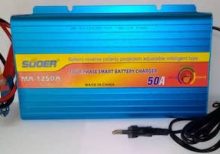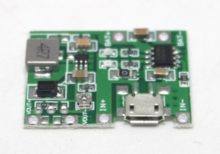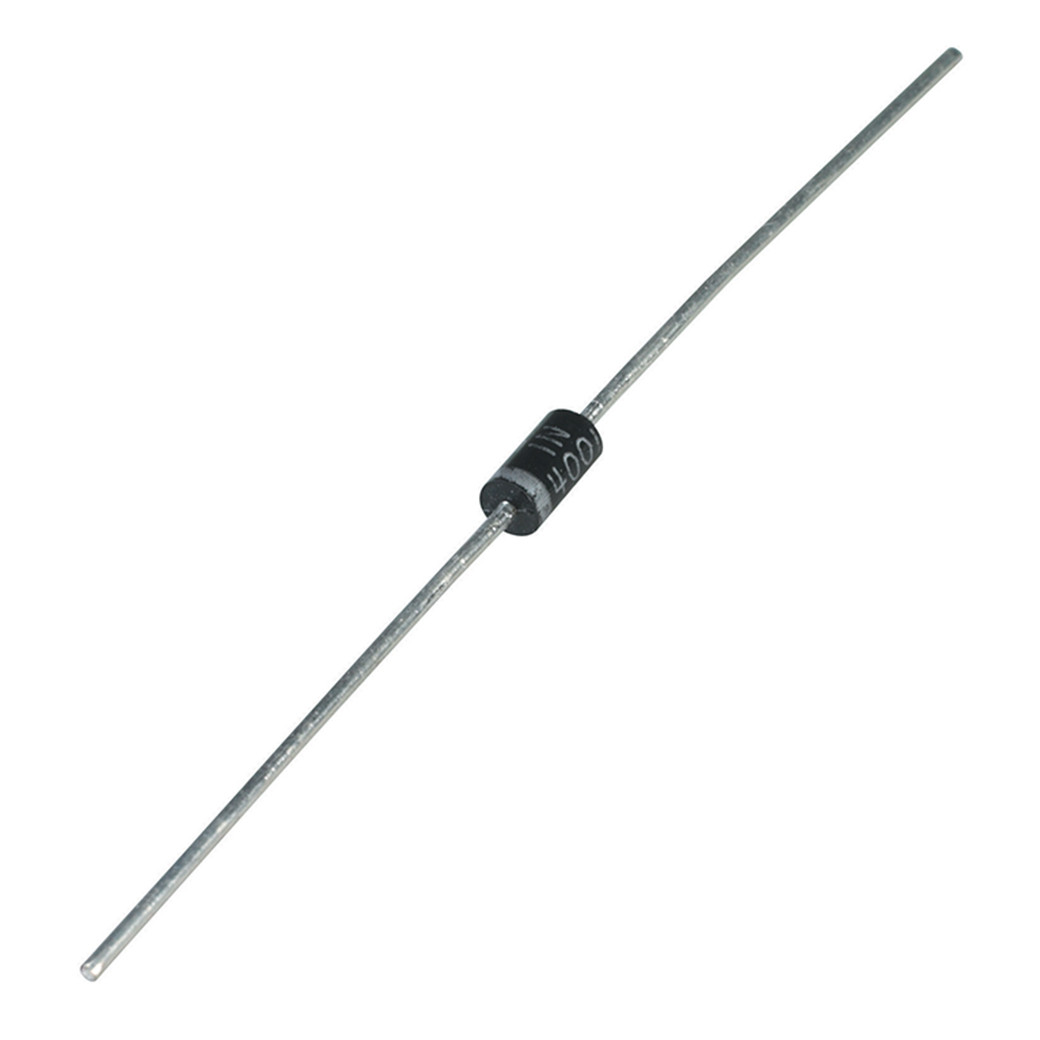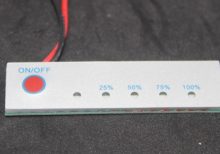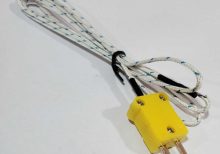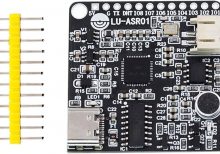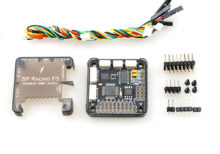|
Description |
The 9V Battery Connector is a convenient and reliable accessory used to connect 9V batteries to electronic circuits and devices. It features a pair of snap connectors that securely attach to the terminals of a 9V battery, providing an easy way to power various projects and components.
Key Features:
- Easy and secure connection to 9V batteries
- Color-coded wires for correct polarity
- Flexible and durable leads for reliable connections
- Compatible with various electronic projects and devices
- Lightweight and compact design
Technical Specifications:
- Connector Type: Snap-on for 9V battery
- Wire Length: Typically around 15cm (varies by manufacturer)
- Wire Gauge: 24 AWG (varies by manufacturer)
- Polarity: Red wire for positive (+), black wire for negative (-)
- Material: Plastic housing with metal contacts
- Rated Voltage: 9V
- Current Capacity: Up to 1A
Applications:
- Powering small electronic projects
- Battery-powered devices
- Portable electronics
- Prototyping and breadboarding
- DIY and hobby projects
Usage:
- Connection:
- Snap the connector onto the terminals of a 9V battery, ensuring correct polarity (red wire to positive, black wire to negative).
- Wiring:
- Connect the leads to your circuit or device, observing proper polarity.
- Use solder, connectors, or a breadboard to make secure connections.
- Powering Devices:
- Use the 9V battery and connector to power your electronic projects, ensuring the voltage and current requirements are compatible.
Caution:
- Ensure correct polarity to avoid damaging the battery or connected device.
- Handle the connector and wires carefully to prevent short circuits.
- Avoid excessive bending or pulling on the wires to maintain reliable connections.
|
The SUOER MA-1250A is a 12V 50A smart battery charger designed for charging and maintaining 12V lead-acid batteries, including AGM, GEL, and SLA types. It features a four-phase charging mode for efficient and safe charging. This charger is equipped with various protections and an intelligent charging algorithm, making it ideal for automotive, marine, and other battery charging applications.
Key Features:
- Charging Modes: Four-phase charging (bulk, absorption, float, and equalization)
- Input Voltage: 110V-240V AC, 50/60Hz
- Output Voltage: 12V DC
- Output Current: 50A
- Battery Types: Suitable for 12V lead-acid, AGM, GEL, and SLA batteries
- LCD Display: Displays charging status, voltage, current, and error codes
- Protections: Overcharge, short circuit, reverse polarity, over-temperature, and overcurrent protection
- Cooling: Built-in cooling fan for temperature management
- Automatic Charging: Intelligent charging algorithm for optimal charging and battery maintenance
- Safety: CE and RoHS certified for safety and environmental compliance
Technical Specifications:
- Input Voltage: 110V-240V AC, 50/60Hz
- Output Voltage: 12V DC
- Output Current: 50A
- Charging Phases: Four-phase (bulk, absorption, float, equalization)
- Display: LCD screen for real-time charging status
- Dimensions: 270 mm x 170 mm x 120 mm
- Weight: 3 kg
- Operating Temperature: 0°C to 40°C
- Storage Temperature: -20°C to 70°C
- Humidity: 5% to 95% non-condensing
Applications:
- Automotive: Ideal for charging and maintaining car batteries.
- Marine: Suitable for charging marine batteries on boats and yachts.
- RV: Perfect for charging and maintaining RV batteries.
- Industrial: Useful for charging batteries in industrial equipment and machinery.
- Backup Power: Can be used for charging batteries in backup power systems.
Datasheet:
For detailed technical information, refer to the SUOER MA-1250A Datasheet
Manufacturer: SUOER
|
The Allen key, also known as a hex key or hex wrench, is a small hand tool used to drive screws and bolts with hexagonal sockets. The Size 4 mm Allen key is designed to fit fasteners with a 4 mm hexagonal socket. This tool is commonly used in various mechanical, electrical, and DIY applications.
Key Features:
- Size: 4 mm (hexagonal socket size)
- Shape: L-shaped or T-shaped
- Material: Typically made from steel or chrome vanadium for durability and strength
- Finish: Often coated with black oxide or chrome plating for corrosion resistance
- Type: Can come in various designs such as short or long arm, ball-end, or standard
Technical Specifications:
- Hexagon Size: 4 mm
- Length: Varies depending on design (e.g., 60 mm to 150 mm for short arm, longer for T-handle or L-handle)
- Material: Steel, chrome vanadium, or other hardened materials
- Finish: Black oxide, chrome-plated, or other protective coatings
Applications:
- Mechanical Work: Used in automotive repair, machinery assembly, and other mechanical tasks.
- Furniture Assembly: Commonly used for assembling flat-pack furniture.
- Bicycles: Used for adjusting and tightening components on bicycles.
- Electronics: Helpful in assembling and repairing electronic devices with hex screws.
- DIY Projects: Essential for various home improvement and hobbyist tasks.
Datasheet:
Typically, Allen keys do not have detailed datasheets, but specifications can be obtained from this datasheet.
|
The 18650 2A LiPo Charger and Discharging Module is a versatile and efficient solution for charging and discharging 18650 lithium-ion batteries. This module provides reliable and safe charging with built-in protection features, making it ideal for various battery-powered applications. It ensures that your batteries are charged efficiently and protected from overcharging, over-discharging, and short circuits.
Key Features:
- Dual Functionality: Supports both charging and discharging of 18650 LiPo batteries.
- 2A Charging Current: Provides a fast and efficient charging process.
- Protection Features: Includes overcharge, over-discharge, and short circuit protection.
- LED Indicators: Displays charging status and operational states.
- Compact Design: Easy to integrate into various battery-powered projects.
- Micro USB Input: Convenient charging via standard Micro USB cables.
Technical Specifications:
- Input Voltage: 5V DC (Micro USB input)
- Charging Current: Up to 2A
- Discharging Current: Up to 2A
- Battery Type: 18650 LiPo batteries
- Protection Features: Overcharge, over-discharge, short circuit protection
- LED Indicators: Charging (red), fully charged (green), discharging (blue)
- Operating Temperature Range: -20°C to +60°C
- Dimensions: 36mm x 18mm x 8mm
- Weight: 7g
Applications:
- Portable Electronics: Suitable for powering and charging portable devices.
- DIY Battery Packs: Ideal for custom battery pack projects.
- RC Vehicles: Ensures efficient charging and discharging for RC cars, drones, and other vehicles.
- Power Banks: Enhances power banks with reliable battery management.
- Renewable Energy Systems: Useful in solar-powered and other renewable energy projects.
Datasheet:
For detailed technical specifications, refer to the 18650 2A LiPo Charger and Discharging Module Datasheet.
|
The LiPo Battery 7.4V 2400mAh is a rechargeable lithium polymer battery commonly used in high-performance applications such as drones, RC vehicles, and other electronics. Its high capacity and stable voltage make it suitable for applications requiring reliable and extended power supply. This battery offers a balance between size, weight, and power output.
Key Features:
- Voltage: 7.4V (nominal)
- Capacity: 2400mAh
- Chemistry: Lithium Polymer (LiPo)
- Discharge Rate: Typically high discharge rates available (e.g., 20C to 30C)
- Charge Rate: Safe charging rate, typically 1C (2400mA)
- Compact Design: Lightweight and compact for easy integration
- Protection Circuit: Often includes built-in protection to prevent overcharging and over-discharging (varies by manufacturer)
Technical Specifications:
- Dimensions:
- Length: 100 mm (typical)
- Width: 35 mm (typical)
- Height: 15 mm (typical)
- Weight: Approximately 150 g
- Nominal Voltage: 7.4V
- Capacity: 2400mAh
- Discharge Rate:
- Continuous: Typically 20C to 30C (e.g., 48A to 72A)
- Peak: Higher rates available depending on model
- Charge Rate: 1C (2400mA) or as specified by manufacturer
- Connector Type: JST or XT60 (varies by model)
- Battery Type: Lithium Polymer (LiPo)
- Protection Circuit: Built-in protection (varies by model)
Applications:
- Drones: Provides power for multirotor drones and other UAVs.
- RC Vehicles: Suitable for remote-controlled cars, boats, and planes.
- Electronics Projects: Ideal for DIY electronics and prototyping projects requiring reliable power.
- High-Power Devices: Used in devices requiring high discharge rates and extended battery life.
Datasheet:
For detailed technical information, refer to the LiPo Battery 7.4V 2400mAh Datasheet.
|
The 4S 40A 18650 Balanced Battery Management System (BMS) with Protection Board is designed to manage and protect a 4-series (4S) lithium-ion battery pack, typically using 18650 cells. This BMS ensures the safe operation of the battery pack by balancing the charge among cells, preventing overcharge, over-discharge, and overcurrent conditions. It is ideal for use in battery packs for electric vehicles, power tools, and other high-power applications.
Key Features:
- Suitable for 4-series (4S) lithium-ion battery packs
- Supports a continuous discharge current of up to 40A
- Provides cell balancing to ensure uniform charging
- Protection against overcharge, over-discharge, and overcurrent
- Short-circuit protection
- Built-in temperature protection
- Compact and lightweight design
Technical Specifications:
- Battery Configuration: 4S (4-series)
- Continuous Discharge Current: 40A
- Overcharge Protection Voltage: Typically 4.25V ±0.05V per cell
- Overdischarge Protection Voltage: Typically 2.8V ±0.05V per cell
- Balance Current: Typically 30mA
- Balance Voltage: Typically 4.2V ±0.05V per cell
- Overcurrent Protection: Activated at 60A (±5A)
- Short-Circuit Protection: Yes
- Operating Temperature Range: -20°C to +60°C
- Dimensions: Varies by manufacturer
- Weight: Varies by manufacturer
Applications:
- Electric Vehicles: Provides reliable battery management for electric cars, bikes, and scooters.
- Power Tools: Ensures safe and efficient operation of battery-powered tools.
- Energy Storage Systems: Manages and protects battery packs in solar and renewable energy storage solutions.
- Portable Devices: Enhances the safety and performance of high-capacity portable battery packs.
Usage:
- Connect the BMS to the battery pack according to the wiring diagram provided by the manufacturer.
- Ensure proper insulation and secure connections to prevent short circuits and other hazards.
- Install the BMS in a well-ventilated area to allow heat dissipation and prevent overheating.
- Monitor the battery pack during initial use to ensure proper operation and protection features.
- Regularly check the connections and condition of the BMS to maintain optimal performance.
Caution:
- Follow the wiring diagram carefully to avoid incorrect connections that can damage the BMS or battery pack.
- Do not exceed the rated current and voltage limits to prevent overheating and potential failure.
- Handle with care to avoid physical damage to the BMS components.
- Ensure proper ventilation to prevent overheating during high-current operation.
- Keep away from moisture and extreme temperatures to maintain reliability and longevity.
|
The 1N4001 is a general-purpose rectifier diode designed for a wide range of applications including power supplies, converters, and freewheeling diodes. This silicon diode is known for its reliability, low forward voltage drop, and high surge current capability. It is suitable for use in circuits requiring rectification, reverse polarity protection, and other general-purpose diode functions.
Key Features:
- Type: Silicon rectifier diode
- Forward Voltage Drop (Vf): Typically 1.1V at 1A
- Average Rectified Current (Io): 1A
- Peak Repetitive Reverse Voltage (Vrrm): 50V
- Surge Current (Ifsm): 30A
- Recovery Time: Standard recovery
- Package: DO-41
Technical Specifications:
- Maximum Repetitive Peak Reverse Voltage (Vrrm): 50V
- Maximum RMS Voltage (Vrms): 35V
- Maximum DC Blocking Voltage (Vdc): 50V
- Average Rectified Output Current (Io): 1A
- Non-Repetitive Peak Forward Surge Current (Ifsm): 30A
- Forward Voltage (Vf): 1.1V at 1A
- Reverse Current (Ir): 5µA at 50V
- Operating Temperature Range: -65°C to +150°C
Applications:
- Power supply rectification
- Freewheeling diode in motor applications
- Reverse polarity protection
- Converters and inverters
- General-purpose diode functions
Usage:
- Connect the anode (positive lead) to the positive side of the circuit.
- Connect the cathode (marked with a band) to the negative side of the circuit.
- Ensure the diode is correctly oriented to prevent reverse voltage damage.
- Integrate the diode into the circuit to achieve the desired rectification or protection function.
Caution:
- Verify the voltage and current ratings to ensure compatibility with your circuit.
- Avoid exceeding the maximum ratings to prevent damage to the diode.
- Ensure proper thermal management if operating near maximum current ratings.
Datasheet:
For detailed technical specifications, refer to the 1N4001 Diode Datasheet.
|
The ACS712 is a current sensor from Allegro Microsystems designed to measure current with a maximum rating of 30A. It provides an analog output voltage that is proportional to the current flowing through the sensor. The ACS712 is widely used in power monitoring, load current measurement, and over-current protection applications due to its high accuracy and ease of integration with microcontrollers and other electronic systems.
Key Features:
- Measures AC and DC current up to 30A
- Provides an analog output voltage proportional to the current
- High accuracy with low offset and temperature drift
- Integrated Hall effect sensor for non-invasive current measurement
- Small size and easy to integrate into various circuits
- On-chip signal conditioning and protection
Technical Specifications:
- Sensor Type: Hall Effect Current Sensor
- Current Range: ±30A (AC or DC)
- Output Voltage Range: Typically 0V to Vcc
- Sensitivity: 66mV/A (typical)
- Operating Voltage: 5V ±5%
- Zero Current Offset Voltage: Vcc/2 (typical)
- Temperature Range: -40°C to +85°C
- Current Measurement Accuracy: ±1.5% of full-scale current (typical)
- Package Type: SOP-8 or similar
Applications:
- Power monitoring and control
- Over-current protection systems
- Load current measurement in power supplies
- Motor current sensing
- Energy monitoring and management
Usage:
- Connect the ACS712 sensor to your microcontroller or development board, ensuring correct connection of the power supply (Vcc, GND) and the output voltage pin.
- Route the current-carrying conductor through the sensor to measure the current.
- Read the analog output voltage, which is proportional to the current, and process it according to your application needs.
- Calibrate the sensor if necessary to ensure accurate current measurement.
Caution:
- Ensure the current flowing through the sensor does not exceed the maximum rating (30A) to avoid damage.
- Properly insulate and protect the sensor and connections to prevent short circuits and ensure safe operation.
- Verify the power supply voltage and connections to avoid incorrect readings or sensor damage.
Datasheet:
For detailed technical specifications, refer to the ACS712 Datasheet.
|
Description: The 3S LiPo / 12V Battery Power Level Indicator is a compact and versatile module designed to monitor the voltage level of 3-cell lithium polymer (LiPo) batteries or 12V lead-acid batteries. It provides users with visual indicators to easily gauge the remaining charge level, ensuring optimal usage and preventing over-discharge. This module is essential for applications such as RC vehicles, drones, portable electronics, and solar power systems, where accurate battery monitoring is crucial for safe operation.
Key Features:
- Monitors 3S LiPo batteries (11.1V nominal) or 12V lead-acid batteries
- LED indicators for quick visual feedback of battery charge level
- Precise voltage detection for accurate monitoring
- Compact and lightweight design for easy integration
- Low power consumption
- Reverse polarity protection for added safety
- Easy to install and operate
Technical Specifications:
- Battery Compatibility: 3S LiPo (11.1V nominal) or 12V Lead-Acid
- Input Voltage Range: 9V to 15V
- Display: LED indicators for different voltage levels (e.g., 100%, 75%, 50%, 25%)
- Accuracy: ±0.1V
- Operating Temperature: -10°C to +50°C
- Dimensions: Compact size suitable for various applications
- Weight: Lightweight for minimal impact on device weight
Applications:
- RC Vehicles and drones for monitoring battery status during operation
- Portable electronics requiring reliable battery monitoring
- Solar power systems to track battery charge levels
- DIY projects and prototypes needing accurate power management
- Automotive and marine applications for battery health monitoring
|
The DHT11 is a basic, ultra-low-cost digital temperature and humidity sensor. It uses a capacitive humidity sensor and a thermistor to measure the surrounding air and outputs a digital signal on the data pin. It’s simple to use but requires careful timing to grab data. It’s perfect for DIY projects, weather stations, and other applications where accurate and reliable temperature and humidity readings are needed.
Key Features:
- Temperature Range: 0-50°C with ±2°C accuracy
- Humidity Range: 20-80% RH with ±5% RH accuracy
- Low Power Consumption: Efficient for battery-operated applications
- Single Wire Digital Interface: Easy to interface with microcontrollers
- Pre-calibrated: No need for additional calibration
- Compact Size: Suitable for compact projects and devices
Technical Specifications:
- Temperature Range: 0-50°C (32-122°F)
- Humidity Range: 20-80% RH
- Temperature Accuracy: ±2°C
- Humidity Accuracy: ±5% RH
- Operating Voltage: 3.3V to 5.5V
- Max Current: 2.5mA
- Output: Digital signal via 1-wire protocol
- Dimensions: 15.5mm x 12mm x 5.5mm
Applications:
- Weather Stations: Monitor and log temperature and humidity levels.
- Home Automation: Control HVAC systems based on environmental conditions.
- Greenhouses: Maintain optimal growing conditions for plants.
- DIY Projects: Perfect for hobbyists building custom sensors and gadgets.
- Data Loggers: Record environmental data over time for analysis.
- Educational Projects: Teach students about sensors and data acquisition.
Usage:
- Wiring: Connect the VCC pin to 3.3V or 5V, GND to ground, and the DATA pin to a digital input on your microcontroller.
- Library Integration: Use libraries available for platforms like Arduino or Raspberry Pi to simplify reading data from the sensor.
- Coding: Write code to initialize the sensor and read temperature and humidity data.
- Data Processing: Process and use the sensor data in your application as needed, such as displaying it on an LCD or sending it to a web server.
Caution:
- Power Supply: Ensure the sensor is supplied with the correct voltage to avoid damage.
- Environmental Conditions: Keep the sensor in a dust-free, non-condensing environment for accurate readings.
- Wiring Length: Minimize the length of wiring between the sensor and the microcontroller to maintain signal integrity.
Datasheet:
For detailed technical specifications, refer to the DHT11 Datasheet.
|
Description:
This thermocouple probe is designed for accurate temperature measurement in the range of -50°C to 400°C (-58°F to 752°F). It consists of a fine gauge wire made from two dissimilar metals (usually chromel and alumel for Type K thermocouples), which generate a voltage proportional to the temperature difference between the measurement junction and the reference junction. The probe is constructed with high-quality materials to ensure durability and reliability in various industrial, laboratory, and HVAC applications.
Key Features:
- Type: K thermocouple (common for general-purpose applications)
- Temperature Range: -50°C to 400°C (-58°F to 752°F)
- Probe Length: Standard lengths available, such as 1 meter (custom lengths may be available)
- Fast response time
- High accuracy and repeatability
- Suitable for harsh environments and high-temperature applications
- Flexible and easy to install
- Compatible with standard thermocouple connectors
Technical Specifications:
- Type: K thermocouple (other types available depending on application)
- Temperature Range: -50°C to 400°C (-58°F to 752°F)
- Accuracy: Typically ±1.5°C or ±0.4% (whichever is greater)
- Probe Diameter: Standard diameters available, typically 0.5 mm to 6 mm
- Response Time: Typically within a few seconds
- Sheath Material: Stainless steel, Inconel, or other suitable alloys
- Connection Type: Standard thermocouple connector, such as miniature thermocouple plugs or sockets
Applications:
- Industrial Temperature Monitoring
- HVAC (Heating, Ventilation, and Air Conditioning)
- Food Processing and Refrigeration
- Laboratory Testing and Calibration
- Process Control Systems
- Automotive and Aerospace
Datasheet:
For detailed technical information, refer to the datasheet
|
The 20W Hot Melt Glue Gun is a versatile adhesive tool designed for use with hot glue sticks. It heats and melts glue sticks, allowing for quick and easy bonding of various materials such as wood, plastic, fabric, and metal. Ideal for crafting, DIY projects, and repairs, this glue gun provides precise control and strong adhesive bonds.
Key Features:
- 20W power rating for efficient heating and melting of glue
- Ergonomic design for comfortable handling
- Adjustable stand for stability during use
- Quick heating time for faster work
- Compatible with standard hot glue sticks (usually 7mm or 11mm diameter)
- On/Off switch for convenient operation
Technical Specifications:
- Power Rating: 20W
- Voltage: Typically 220V AC (varies by region)
- Heat Time: Approximately 3-5 minutes to reach operating temperature
- Temperature Range: Approximately 160°C to 180°C (320°F to 356°F)
- Glue Stick Diameter: Compatible with 7mm or 11mm diameter glue sticks
- Weight: Typically around 150-200 grams
- Material: Plastic body with metal nozzle
Applications:
- Crafting and DIY projects
- Repairs of household items and electronics
- Assembly of wooden, plastic, and metal parts
- Artistic and creative projects
- General-purpose adhesive applications
Usage:
- Insert the glue stick into the rear of the glue gun.
- Plug in the glue gun and turn it on using the switch.
- Wait for 3-5 minutes for the glue gun to heat up and melt the glue.
- Squeeze the trigger to apply the molten glue to the surfaces you wish to bond.
- Hold the surfaces together until the glue sets (usually within 10-20 seconds).
- Turn off the glue gun and unplug it when not in use.
Caution:
- Handle the glue gun carefully to avoid burns from the hot glue and the heated nozzle.
- Ensure the glue gun is placed on a heat-resistant surface or its stand while in use.
- Keep out of reach of children and follow the manufacturer’s safety instructions.
Datasheet:
For detailed technical specifications, refer to the 20W Hot Melt Glue Gun Datasheet.
|
|
The 125KHZ RFID Card is a contactless proximity card used for various identification and access control applications. It operates at a frequency of 125kHz and contains a unique identification number (UID) for each card. This card is durable and convenient, making it ideal for use in security systems, time and attendance tracking, and membership management.
Key Features:
- Operates at 125kHz frequency
- Durable PVC material
- Compatible with standard 125kHz RFID readers
- Unique identification number (UID) for each card
- Waterproof and tamper-resistant
- Long read range (up to 10 cm depending on the reader)
- No battery required (passive RFID technology)
Technical Specifications:
- Operating Frequency: 125kHz
- Material: PVC plastic
- Dimensions: 85.6mm x 54mm x 0.8mm (standard credit card size)
- Weight: Approximately 6g
- Read Range: Up to 10 cm (depending on the reader and environment)
- Data Storage: 64-bit read-only unique identifier (UID)
- Operating Temperature Range: -25°C to +85°C
- Color: Typically white, but may vary by manufacturer
- Waterproof: Yes
Applications:
- Access control systems
- Time and attendance tracking
- Membership management
- Asset tracking
- Secure entry systems
- Contactless payment systems
Usage:
- Integration:
- Enroll the RFID card in the desired RFID system by registering its unique identifier (UID) with the system’s database.
- Operation:
- Present the card to an RFID reader within the read range (up to 10 cm).
- The reader will capture the UID and communicate it to the control system for processing.
- Security:
- Use the card for secure access to restricted areas or for tracking attendance.
- Pair the card with a compatible RFID reader and control system for seamless operation.
Caution:
- Avoid exposing the card to extreme temperatures or harsh chemicals.
- Do not bend or apply excessive force to the card to prevent damage.
- Keep the card away from strong magnetic fields to ensure proper operation.
Datasheet:
For detailed technical specifications, refer to the manufacturer’s datasheet for your specific 125kHz RFID card model.
|
The SP Racing F3 Acro Flight Controller is a popular flight controller designed for multi-rotor and fixed-wing aircraft. It is known for its performance and reliability, providing precise control and stabilization for a variety of flying applications. The F3 Acro variant is optimized for acrobatic flying, offering features tailored to enhance the flight experience in high-performance scenarios.
Key Features:
- Processor: Based on the STM32 F3 series microcontroller
- Firmware: Compatible with popular flight control firmware such as Betaflight, Cleanflight, or Raceflight
- Sensor Suite: Includes built-in gyroscope and accelerometer for stabilization and control
- Ports: Multiple input/output ports for connecting to ESCs, receivers, and other peripherals
- Connectivity: UART and I2C interfaces for communication and expansion
- Mounting: Typically comes with mounting holes for easy installation in various frames
Technical Specifications:
- Microcontroller: STM32F303
- Sensor Types: 3-axis gyroscope and 3-axis accelerometer
- Firmware Compatibility: Betaflight, Cleanflight, Raceflight, etc.
- Input Voltage: Usually 5V to 12V (depends on the specific model and setup)
- Dimensions: Varies by model, but generally compact and lightweight
- Weight: Approximately 10 to 20 grams (varies by model)
- Ports: Includes connections for ESCs, receiver, GPS, and other peripherals
Applications:
- Multi-Rotor Drones: Ideal for quadcopters, hexacopters, and other multi-rotor drones.
- Acrobatic Flying: Suitable for high-performance and acrobatic flying due to its advanced stabilization features.
- Racing Drones: Commonly used in FPV (First-Person View) racing drones for precise control and responsiveness.
- Fixed-Wing Aircraft: Can be adapted for use in fixed-wing aircraft with suitable firmware and configuration.
- DIY Projects: Applied in custom-built drones and UAVs for versatile flight control solutions.
Datasheet:
For detailed technical information, refer to the datasheet of the specific SP Racing F3 Acro Flight Controller model, as specifications can vary based on the manufacturer and design.
|

